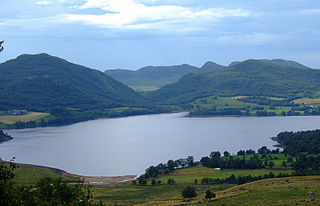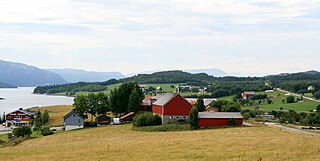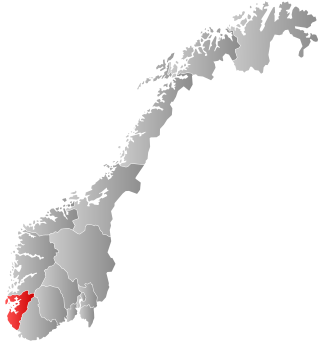
Sandnes is a city and municipality in Rogaland, Norway. It lies immediately south of Stavanger, the 4th largest city in Norway, and together the Stavanger/Sandnes area is the third-largest urban area in Norway. The urban city of Sandnes lies in the extreme western part of the vast municipality and it makes up about 5% of the total land area of the municipality.

Klepp is a municipality in Rogaland county, Norway. It is located in the traditional district of Jæren. The administrative centre of the municipality is the village of Kleppe. Other villages in Klepp include Klepp stasjon, Orre, Orstad, Pollestad, Verdalen, and Voll. Klepp is a flat and open agricultural landscape. The highest point, Tinghaug, is at 102 metres (335 ft) above sea level. There are long stretches of sand beaches along the North Sea coastline in the west.

Gjesdal is a municipality in Rogaland county, Norway. It is located in the traditional district of Jæren. The administrative centre of the municipality is the village of Ålgård. Other villages in Gjesdal include Dirdal, Frafjord, Gilja, Gjesdal, and Oltedal. The municipality lies about 25 kilometres (16 mi) to the southwest of the city of Stavanger in southwestern Norway.

Sola is a municipality and a Seaside resort in Rogaland county, Norway. It is located in the traditional district of Jæren. The administrative centre of the municipality is the village of Solakrossen. Other villages include Tananger, Hålandsmarka, Sørnes, and Stenebyen. Stavanger Airport is located in Sola, just a short distance from the large Stavanger/Sandnes metropolitan area.

Randaberg is a municipality in Rogaland county, Norway. It is located in the traditional district of Jæren, at the northern end of the Stavanger Peninsula. The administrative centre of the municipality is the village of Randaberg.

Stord is a municipality in Vestland county, Norway. It is located in the traditional district of Sunnhordland. Stord is sometimes called "Norway in miniature" since it has such a variety of landscapes: coastline, fjords, forests, agricultural land, and mountain areas. The administrative centre of the municipality is the town of Leirvik, which is also the largest town in the municipality and the whole region of Sunnhordland. Leirvik was declared a town in 1997. Other population centres in the municipality include the large village of Sagvåg and the smaller villages of Litlabø and Grov.

Fosnes is a former municipality in Trøndelag county, Norway. The municipality existed from 1838 until its dissolution in 2020 when it was merged into Namsos Municipality. It was part of the Namdalen region. The administrative centre of the municipality was the village of Dun on the island of Jøa. Other villages include Salsnes and Nufsfjord.

Nærøy is a former municipality in Trøndelag county, Norway. The municipality existed from 1838 until its dissolution in 2020 when it joined Nærøysund Municipality. It was part of the Namdalen region. Norway's smallest town, Kolvereid, was the administrative centre of the municipality. Some villages in Nærøy included Abelvær, Foldereid, Gravvik, Lund, Ottersøy, Salsbruket, Steine, and Torstad.

Strand is a municipality in Rogaland county, Norway. It is located in the traditional district of Ryfylke. The administrative centre of the municipality is the town of Jørpeland. The municipality lies across the fjord from the city of Stavanger. The Ryfast tunnel system connects Stavanger and Strand by a very long undersea tunnel.

Sjernarøy is a former municipality in Rogaland county, Norway. The island municipality existed from 1868 until its dissolution in 1965. The municipality was located in the Boknafjorden in the present-day municipality of Stavanger. The administrative centre of the municipality was located on the island of Kyrkjøy, where the Sjernarøy Church is located.

Skudenes is a former municipality in Rogaland county, Norway. It was part of the traditional district of Haugaland. The 68-square-kilometre (26 sq mi) municipality existed from 1838 until its dissolution in 1965. The administrative centre was the town of Skudeneshavn. The municipality originally encompassed land that is now part of the municipalities of Bokn and Karmøy. It included the southern part of the island of Karmøy and the three islands to the east: Vestre Bokn, Austre Bokn, and Ognøya. In 1849, the three smaller islands were separated to form Bokn municipality.

Sogndal is a former municipality and small seaport (ladested) in Rogaland county, Norway. The municipality is located on the coast in the traditional district of Dalane. The 19-hectare (47-acre) municipality existed from 1845 until its dissolution in 1944 when it was merged into the municipality of Sokndal. It comprised the two harbor villages: the 7-hectare (17-acre) Sogndalsstranda and the 12-hectare (30-acre) Rægefjord. The river Sogndalselva reaches the ocean at Songdalsstranda.

Høyland is a former municipality in Rogaland county, Norway. The 170-square-kilometre (66 sq mi) municipality was located at the innermost end of the Gandsfjorden in the western part of the present-day municipality of Sandnes. The municipality existed from 1838 until its dissolution in 1965. The main church for the municipality was Høyland Church.

Leinstrand is a former municipality in the old Sør-Trøndelag county, Norway. The 46-square-kilometre (18 sq mi) municipality existed from 1838 until its dissolution in 1964. The municipality of Leinstrand encompassed the south-central part of what is now the city of Trondheim in Trøndelag county. The administrative centre was located in the village of Heimdal, just west of the border with Tiller municipality. The local Leinstrand Church was built in 1673.

Nedstrand is a former municipality in Rogaland county, Norway. The 119-square-kilometre (46 sq mi) municipality was located along the Nedstrandfjorden, an inner branch off the main Boknafjorden. The municipality encompassed the majority of the Nedstrand peninsula. Originally it also included the Sjernarøyane islands and the western part of the island of Ombo in the fjord to the south. The administrative centre of the municipality was the village of Nedstrand. Nedstrand Church is located in Hindaråvåg, a small village just west of Nedstrand village. Today, the area is part of the large municipality of Tysvær.

Høle or Høgsfjord is a former municipality in Rogaland county, Norway. The large municipality existed from 1865 until 1965. It was called Høgsfjord from 1865 until 1871 when the municipality was reduced in size and the name was changed to Høle. The municipality originally was quite large, surrounding both sides of the Høgsfjorden and Lysefjorden. Throughout its history, it included large parts of the present-day municipalities of Sandnes and Gjesdal. Since 1965, the area of Høle has been the borough of Høle in Sandnes municipality. Høle Church was the main church of the municipality.

Madla is a former municipality in Rogaland county, Norway. The 15.75-square-kilometre (6.08 sq mi) municipality existed from 1930 until 1965 when it was merged into Stavanger Municipality. The small municipality now exists as the borough of Madla inside the city of Stavanger, on the northeast side of the Hafrsfjorden. It was one of the smallest municipalities in Rogaland county, with only four farms: Malde, Revheim, and North- and South-Sunde. The municipal centre was located at Malde, now known as Madlamark.

Helleland is a former municipality in Rogaland county, Norway. The 148-square-kilometre (57 sq mi) municipality existed from 1838 until its dissolution in 1965. The municipality is now located in the central part of the present-day municipality of Eigersund. The administrative centre of the municipality was the village of Helleland where the Helleland Church is located.

Støren (help·info) is a former municipality in the old Sør-Trøndelag county, Norway. The 266-square-kilometre (103 sq mi) municipality existed from 1838 until its dissolution in 1964. The municipality was located in the north-central part of what is now the municipality of Midtre Gauldal in Trøndelag county. The administrative center was the village of Støren where Støren Church is located.

Stadsbygd is a former municipality in the old Sør-Trøndelag county, Norway. The municipality existed from 1838 until its dissolution in 1964. The 137-square-kilometre (53 sq mi) municipality existed on the southern part of the Fosen peninsula, along the Trondheimsfjorden in what is now the municipality of Indre Fosen in Trøndelag county. The administrative centre was the village of Stadsbygd, just north of the Stadsbygd Church.




















